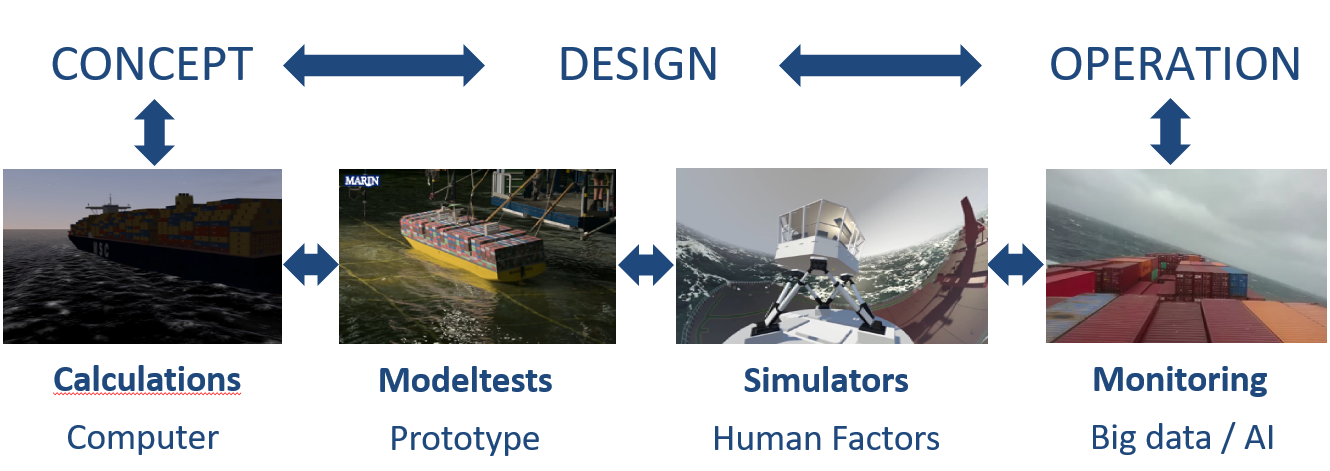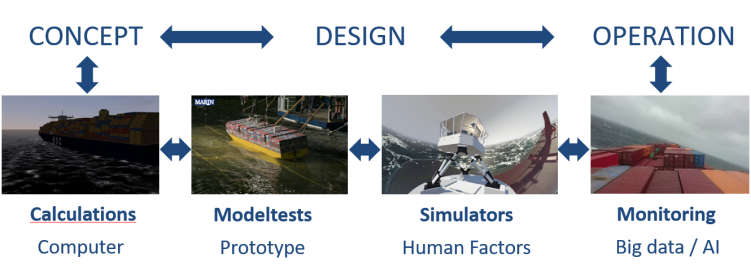With the symbolic handling of a telegraph, the King set 'the sea of the future' in motion. After the opening ceremony, the King was given a tour of the SOSc.
Better Ships, Blue Oceans
Bas Buchner, President
More info

www.marin.nl/sosc
Bas Buchner
President











Opened
May 28!
June 2024, no. 140
Create a MARIN account to stay updated

The Seven Oceans Simulator centre including the 16 m spherical dome of the Large Motion Simulator.





The involvement of the future crew in the design of the ship and its operation is a prerequisite for an optimum ship and offshore structure design. We call this ‘crew-centred ship design and operation’. By investing in this facility, MARIN has an ultra-modern digital and virtual workspace to stimulate this development in the maritime sector. Advanced digital twinning on simulators allows the engineers and crew to experience and improve ships in operational conditions together before they are built.
Essential aspects of the SOSc
The SOSc is an innovative research facility with large spherical and moving simulators, a mixed reality Maritime eXperience Lab (MX Lab) and these are combined with human factor measurement and observation techniques which we can use flexibly to simulate and evaluate complex maritime operations. The Traffic & Mission Control (TMC) is a multi-purpose and flexible room with projection on three walls to simulate control or command centres on board or ashore, and can be coupled to the other simulators and the MX Lab. In the MX Lab, the latest VR/AR systems are researched and applied for maritime systems and operations, both above and below water. All simulators can be interconnected to realistically simulate complex multi-ship and multi-tool operations.
Each link in this chain makes use of dedicated facilities: calculations on the large computer cluster (10,000 cores), experiments in our unique basins (such as the Offshore Basin, Seakeeping & Manoeuvring Basin and Depressurised Wave Basin), simulator studies and data science (with the sea as our digital lab).
World-leading in maritime applied research
In this chain, our older simulators from 1992 were becoming the weakest link. To remain world-leading in the field of maritime applied research, MARIN decided to explore new horizons in simulator and VR technology as we realised that the focus of our future research should be on the actual use of the ship in operational conditions. The idea of the SOSc was born. Here, we want to bridge the gap between engineering and operation.
In the meantime, the operations we expect from crews at sea become more and more complex: installation and maintenance of fixed and floating wind turbines, crew transfers in heavy weather, launch and recovery of unmanned systems. And once in operation, these unmanned and autonomous systems and ships require monitoring and control, from ships or from the shore. At the same time, ships are becoming bigger, and our seas increasingly congested to support the transition to more sustainable energy (wind, solar, tidal, waves) and food (fish, seaweed).
This raises all kinds of questions. How do we prevent these accidents and how do we want the crew to react to accidents? How do we prepare a crew for their increasingly complex tasks at sea? How do we design ships and their operations to support crews in their important role and involve them in this process? And how do we design and use maritime infrastructure (waterways, ports and seas) when there is less space for good seamanship? To help answer these difficult questions, MARIN decided to build the new SOSc.
The decision to invest in the new SOSc is driven by our mission to contribute to clean, smart and safe shipping and a sustainable and free use of the ocean.
Crew-centred ship design and operation
Here, we introduce the SOSc, which represents a bridge to crew-centred ship design and operation.
Sadly, serious shipping accidents regularly occur on our waterways and seas. And these pose major risks to the crew, passengers, the environment and economy (lost cargo, blockades of ports and waterways). Analysis shows that accidents are often the result of human behaviour, or that there was an inadequate response to emergencies.
Report
King Willem-Alexander declares the new Seven Oceans Simulator centre open!
MARIN’s state-of-the-art Seven Oceans Simulator centre (SOSc) is officially declared open by His Majesty King Willem-Alexander of the Netherlands. In front of 275 esteemed guests from the maritime sector, government and research institutes, King Willem-Alexander set the ship’s telegraph at full speed, marking this important milestone in MARIN’s history.
After the tour in the SOSc, the King spoke with those involved in the development and realisation of the simulator centre and with several MARIN partners from the maritime sector. He praised the centuries of nautical inventiveness that come together in this centre and advised anyone with a heart for the maritime sector to visit MARIN.




www.marin.nl/sosc
More info
Better Ships, Blue Oceans
After the tour in the SOSc, the King spoke with those involved in the development and realisation of the simulator centre and with several MARIN partners from the maritime sector. He praised the centuries of nautical inventiveness that come together in this centre and advised anyone with a heart for the maritime sector to visit MARIN.
The involvement of the future crew in the design of the ship and its operation is a prerequisite for an optimum ship and offshore structure design. We call this ‘crew-centred ship design and operation’. By investing in this facility, MARIN has an ultra-modern digital and virtual workspace to stimulate this development in the maritime sector. Advanced digital twinning on simulators allows the engineers and crew to experience and improve ships in operational conditions together before they are built.
Essential aspects of the SOSc
The SOSc is an innovative research facility with large spherical and moving simulators, a mixed reality Maritime eXperience Lab (MX Lab) and these are combined with human factor measurement and observation techniques which we can use flexibly to simulate and evaluate complex maritime operations. The Traffic & Mission Control (TMC) is a multi-purpose and flexible room with projection on three walls to simulate control or command centres on board or ashore, and can be coupled to the other simulators and the MX Lab. In the MX Lab, the latest VR/AR systems are researched and applied for maritime systems and operations, both above and below water. All simulators can be interconnected to realistically simulate complex multi-ship and multi-tool operations.
Bas Buchner, President
Each link in this chain makes use of dedicated facilities: calculations on the large computer cluster (10,000 cores), experiments in our unique basins (such as the Offshore Basin, Seakeeping & Manoeuvring Basin and Depressurised Wave Basin), simulator studies and data science (with the sea as our digital lab).
World-leading in maritime applied research
In this chain, our older simulators from 1992 were becoming the weakest link. To remain world-leading in the field of maritime applied research, MARIN decided to explore new horizons in simulator and VR technology as we realised that the focus of our future research should be on the actual use of the ship in operational conditions. The idea of the SOSc was born. Here, we want to bridge the gap between engineering and operation.


Bas Buchner
President
June 2024, no. 140





The Seven Oceans Simulator centre including the 16 m spherical dome of the Large Motion Simulator.
In the meantime, the operations we expect from crews at sea become more and more complex: installation and maintenance of fixed and floating wind turbines, crew transfers in heavy weather, launch and recovery of unmanned systems. And once in operation, these unmanned and autonomous systems and ships require monitoring and control, from ships or from the shore. At the same time, ships are becoming bigger, and our seas increasingly congested to support the transition to more sustainable energy (wind, solar, tidal, waves) and food (fish, seaweed).
This raises all kinds of questions. How do we prevent these accidents and how do we want the crew to react to accidents? How do we prepare a crew for their increasingly complex tasks at sea? How do we design ships and their operations to support crews in their important role and involve them in this process? And how do we design and use maritime infrastructure (waterways, ports and seas) when there is less space for good seamanship? To help answer these difficult questions, MARIN decided to build the new SOSc.
The decision to invest in the new SOSc is driven by our mission to contribute to clean, smart and safe shipping and a sustainable and free use of the ocean.
Crew-centred ship design and operation
Here, we introduce the SOSc, which represents a bridge to crew-centred ship design and operation.
Sadly, serious shipping accidents regularly occur on our waterways and seas. And these pose major risks to the crew, passengers, the environment and economy (lost cargo, blockades of ports and waterways). Analysis shows that accidents are often the result of human behaviour, or that there was an inadequate response to emergencies.
Opened
May 28!
MARIN’s state-of-the-art Seven Oceans Simulator centre (SOSc) is officially declared open by His Majesty King Willem-Alexander of the Netherlands. In front of 275 esteemed guests from the maritime sector, government and research institutes, King Willem-Alexander set the ship’s telegraph at full speed, marking this important milestone in MARIN’s history.
KingWillem-Alexander declares the new Seven Oceans Simulator centre open!
Report
Create a MARIN account to stay updated





